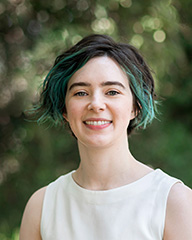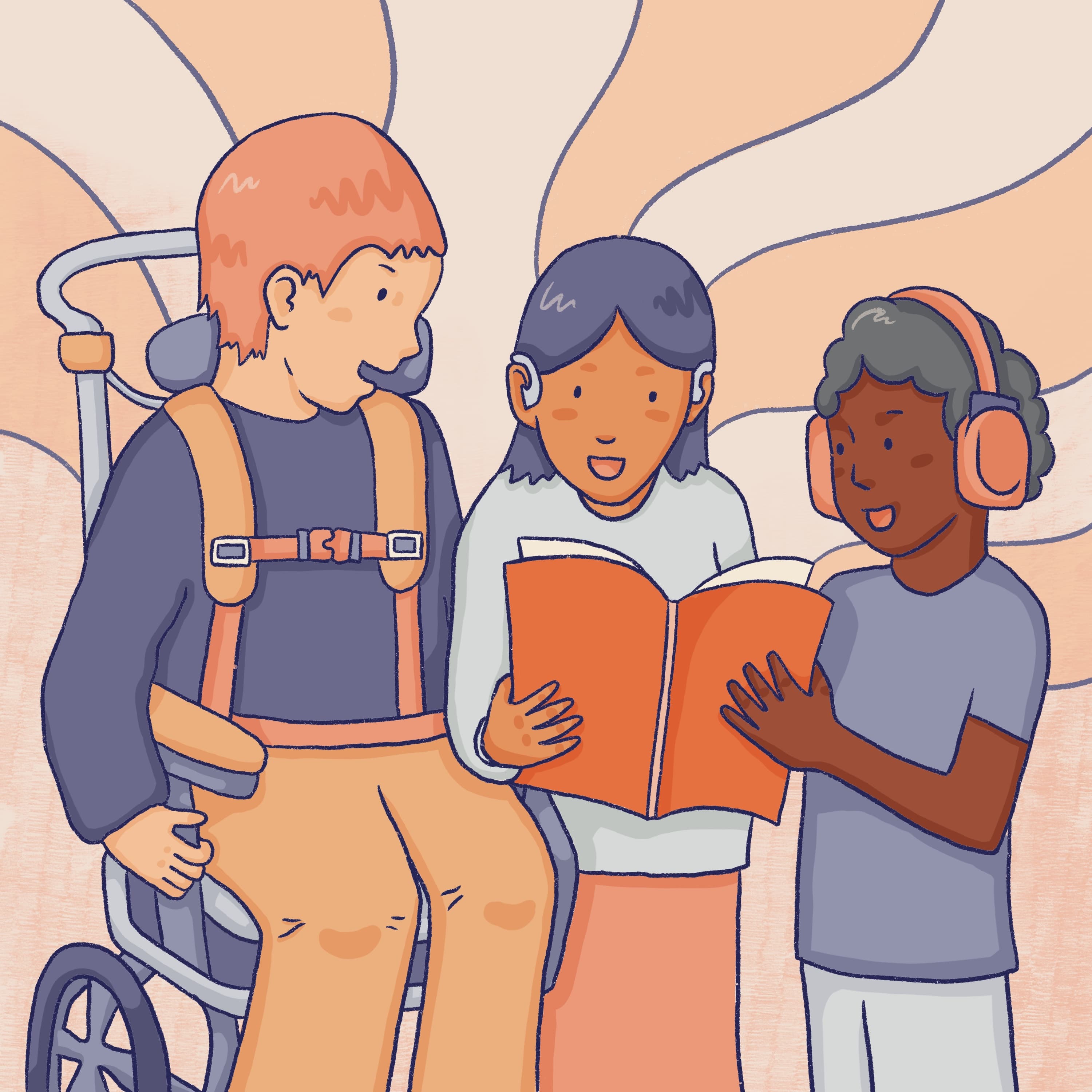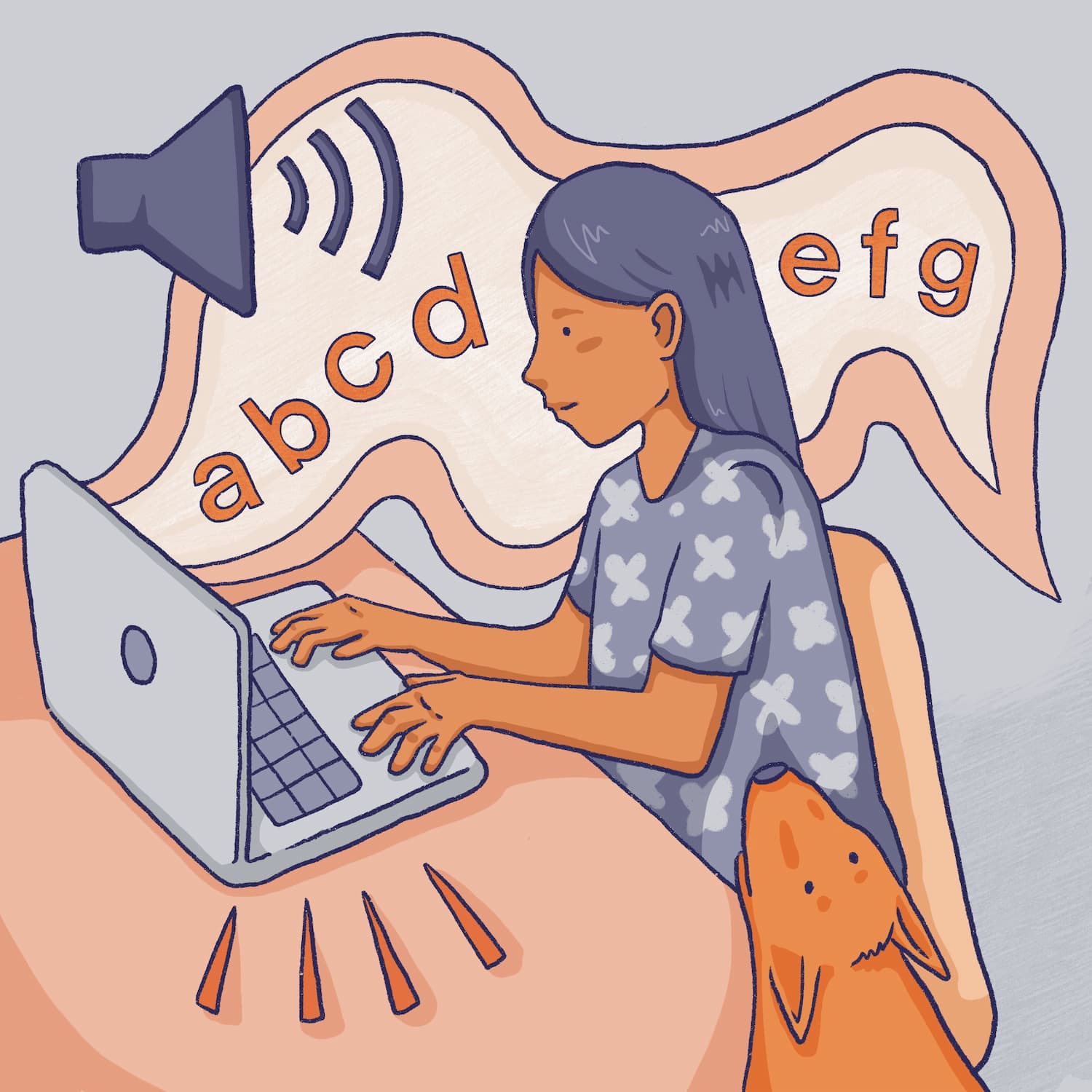Each member of our team is passionate about the role we play in making a positive impact in the community. Learn more about the people behind the passion and what makes them proud to be part of the work we do.
Introducing Annabel (Annie)

I grew up near Kinglake in a little cottage surrounded by acres of bushland. I have fond memories of running around outside with our dogs, going on long rambly walks and seeing the wild, misty landscape out the window every morning. Waking up to peaceful bush sounds and birds like crimson rosellas and lyrebirds was pretty special.
As a kid, I spent loads of time outside and was constantly drawing. I was also very interested in languages and communication from a young age. It still intrigues me how we can express and share ideas through sounds, shapes and other sensory cues.
My passion and interest in languages led me into a degree in linguistics and German language at Melbourne University. After graduating, I transitioned into English teaching where I gained experience in a busy classroom environment.
Through teaching, I developed a strong desire to create, draw and communicate through images. This led to a Visual Communication Design degree at Monash where I connected my love of drawing with languages.
What is your role at the Information Access Group?
I’m very proud to work at the Information Access Group as a communication designer. A big part of my role involves creating images that visually describe and explain concepts. These images accompany text in the Easy Read documents that we create. Visual images and figures often help people understand complex messages. Elements such as colours, shapes, icons, diagrams and illustrations can quickly convey written information, emotions and stories.
I also run focus group sessions with diverse groups of people online and in person. In focus groups, I evaluate how well our Easy Read documents meet the needs and preferences of the intended audience.
In the sessions, I invite the group to share their feedback on the design, layout, language and content of our documents. I observe how the group interacts with the documents and I ask questions based on the content. User-testing focus groups help us improve our work by identifying what works well and what can be improved, as well as any gaps, errors, or misunderstandings that might arise from our documents.
Tell us about a project you’ve worked on that you are proud of
I’m very proud of the ‘What Do You Think’ project for Association for Children with Disability where we created a digital survey for children with disability to answer, rather than their parents or guardians.
Our team designed the entire survey, making it accessible to the children through a mobile phone or tablet.
The survey and its design included unique digital illustrations and interactive designs, including original characters the kids could engage with! These design elements made it more engaging and interactive for the children, garnering active participation and informative survey results. It was rewarding to get such positive feedback from the children and their parents on the survey design and the client we designed it for.
What do you find most rewarding about the work you do at the Information Access Group?

As a designer, it’s very rewarding to use my skills in the service of accessibility. Language and inaccessible tools or structures can create disadvantages for some people. By broadening the availability of information in different formats at the Information Access Group, I’m able to make content more accessible to a bigger audience. This work feels harmonious and is aligned with values that are very important to me.
I hope that our focus on accessibility ripples out to others and provides encouragement to examine assumptions, ask questions about processes, listen to people with disability and develop informed ways to improve accessibility of information.
You have previously taught English to culturally and linguistically diverse students. What are the similarities between that work and the approach we take at the Information Access Group?
Both roles involve communication and understanding people from diverse backgrounds with different life experiences. As a teacher and as a designer, I’ve regularly provided tools for people to have more agency and choice.
I’m also communicating concepts in a way that’s clearer for my audience to understand. This involves getting to know my audience. At times, both roles have involved testing information, receiving feedback and tailoring communication approaches to meet the needs of the audience.
You are involved in our user testing and accessibility research – what drives your interest in this area?

I’m interested in people and how people do things in different ways. Curiosity and asking questions is an important part of this.
As a general principle, the user and their experience always comes first. As a designer, I’m particularly interested in how to improve designs and to create things that match and fulfill people’s needs.
When you create something, you are operating from a set of assumptions and hypotheses. It’s important to examine these assumptions and to challenge them. Testing your ideas and getting direct user feedback is a good way to help challenge these assumptions. It’s also an important part of user-centred design.
Is it true that you lived on a boat with your family for 3 months?
Yes, my dad is quite the avid sailor and adventurer! And I love being on the water. So when he set off on a sailing trip from Australia to New Zealand, then from New Zealand to Tonga, Fiji and Vanuatu, I had to join.
I was 13 then. I went fishing, made art and ran around beaches for 3 months. I met children and adults from many different backgrounds. This led to a deeper appreciation of people and cultures. It was an extremely rewarding experience to have at that age.
Spending so much time outside as a kid really cemented my love for nature. Being in nature is so humbling. It’s a way to reset and balance us and our busy lives and it reminds me I’m part of a much bigger ecosystem.
You have a background in visual arts and have previously taught painting. How do you nurture this creativity both at work and outside of work?
I feel that it’s important to ‘fill your cup’, especially for creative ventures like writing, music and art-making. I think play and experimentation is a good way to keep your creativity flowing. For me, this involves experimenting with different sounds through music or playing with different paints and colour combinations in art-making. I also try to write every morning.
What did you want to be when you grew up?
At one point I wanted to be a vet! I think my desire to create art and communicate concepts eventually overtook this passion. I’m now very happy to simply spend time with animals!
Each member of our team is passionate about the role we play in making a positive impact in the community. Learn more about the people behind the passion and what makes them proud to be part of the work we do.
Introducing Annabel (Annie)

I grew up near Kinglake in a little cottage surrounded by acres of bushland. I have fond memories of running around outside with our dogs, going on long rambly walks and seeing the wild, misty landscape out the window every morning. Waking up to peaceful bush sounds and birds like crimson rosellas and lyrebirds was pretty special.
As a kid, I spent loads of time outside and was constantly drawing. I was also very interested in languages and communication from a young age. It still intrigues me how we can express and share ideas through sounds, shapes and other sensory cues.
My passion and interest in languages led me into a degree in linguistics and German language at Melbourne University. After graduating, I transitioned into English teaching where I gained experience in a busy classroom environment.
Through teaching, I developed a strong desire to create, draw and communicate through images. This led to a Visual Communication Design degree at Monash where I connected my love of drawing with languages.
What is your role at the Information Access Group?
I’m very proud to work at the Information Access Group as a communication designer. A big part of my role involves creating images that visually describe and explain concepts. These images accompany text in the Easy Read documents that we create. Visual images and figures often help people understand complex messages. Elements such as colours, shapes, icons, diagrams and illustrations can quickly convey written information, emotions and stories.
I also run focus group sessions with diverse groups of people online and in person. In focus groups, I evaluate how well our Easy Read documents meet the needs and preferences of the intended audience.
In the sessions, I invite the group to share their feedback on the design, layout, language and content of our documents. I observe how the group interacts with the documents and I ask questions based on the content. User-testing focus groups help us improve our work by identifying what works well and what can be improved, as well as any gaps, errors, or misunderstandings that might arise from our documents.
Tell us about a project you’ve worked on that you are proud of
I’m very proud of the ‘What Do You Think’ project for Association for Children with Disability where we created a digital survey for children with disability to answer, rather than their parents or guardians.
Our team designed the entire survey, making it accessible to the children through a mobile phone or tablet.
The survey and its design included unique digital illustrations and interactive designs, including original characters the kids could engage with! These design elements made it more engaging and interactive for the children, garnering active participation and informative survey results. It was rewarding to get such positive feedback from the children and their parents on the survey design and the client we designed it for.
What do you find most rewarding about the work you do at the Information Access Group?

As a designer, it’s very rewarding to use my skills in the service of accessibility. Language and inaccessible tools or structures can create disadvantages for some people. By broadening the availability of information in different formats at the Information Access Group, I’m able to make content more accessible to a bigger audience. This work feels harmonious and is aligned with values that are very important to me.
I hope that our focus on accessibility ripples out to others and provides encouragement to examine assumptions, ask questions about processes, listen to people with disability and develop informed ways to improve accessibility of information.
You have previously taught English to culturally and linguistically diverse students. What are the similarities between that work and the approach we take at the Information Access Group?
Both roles involve communication and understanding people from diverse backgrounds with different life experiences. As a teacher and as a designer, I’ve regularly provided tools for people to have more agency and choice.
I’m also communicating concepts in a way that’s clearer for my audience to understand. This involves getting to know my audience. At times, both roles have involved testing information, receiving feedback and tailoring communication approaches to meet the needs of the audience.
You are involved in our user testing and accessibility research – what drives your interest in this area?

I’m interested in people and how people do things in different ways. Curiosity and asking questions is an important part of this.
As a general principle, the user and their experience always comes first. As a designer, I’m particularly interested in how to improve designs and to create things that match and fulfill people’s needs.
When you create something, you are operating from a set of assumptions and hypotheses. It’s important to examine these assumptions and to challenge them. Testing your ideas and getting direct user feedback is a good way to help challenge these assumptions. It’s also an important part of user-centred design.
Is it true that you lived on a boat with your family for 3 months?
Yes, my dad is quite the avid sailor and adventurer! And I love being on the water. So when he set off on a sailing trip from Australia to New Zealand, then from New Zealand to Tonga, Fiji and Vanuatu, I had to join.
I was 13 then. I went fishing, made art and ran around beaches for 3 months. I met children and adults from many different backgrounds. This led to a deeper appreciation of people and cultures. It was an extremely rewarding experience to have at that age.
Spending so much time outside as a kid really cemented my love for nature. Being in nature is so humbling. It’s a way to reset and balance us and our busy lives and it reminds me I’m part of a much bigger ecosystem.
You have a background in visual arts and have previously taught painting. How do you nurture this creativity both at work and outside of work?
I feel that it’s important to ‘fill your cup’, especially for creative ventures like writing, music and art-making. I think play and experimentation is a good way to keep your creativity flowing. For me, this involves experimenting with different sounds through music or playing with different paints and colour combinations in art-making. I also try to write every morning.
What did you want to be when you grew up?
At one point I wanted to be a vet! I think my desire to create art and communicate concepts eventually overtook this passion. I’m now very happy to simply spend time with animals!


